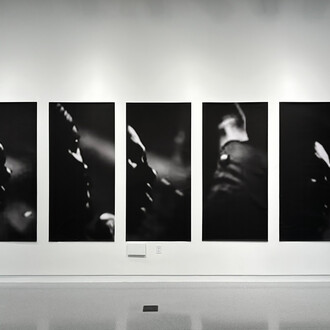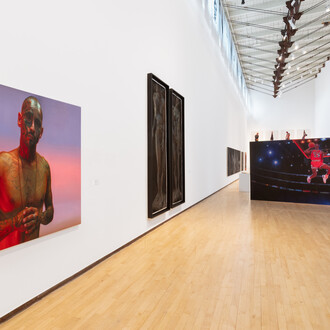Cauleen Smith describes her work as a reflection on “the everyday possibilities of the imagination.” Trained as a filmmaker, the multidisciplinary artist creates visual and phenomenological experiences that ruminate on social, cultural, intellectual, artistic, and political liberation. Her stunning works draw on poetry, Afrofuturism, science fiction, and tactics of experimental film to conjure alternative narratives and what the artist has called “a cornucopia of future histories.” She engages topics and influences as disparate as the African Diaspora, the image of black women in film, the music and legacies of Sun Ra and John Coltrane, the post-hurricane landscape of New Orleans, the work of Dutch conceptualist Bas Jan Ader, the politics of land art, and Martin Luther King Jr.’s writings on “creative maladjustment.” She describes her subjects as “the fragile, the forgotten, the flawed, and the fugitive.”
Spanning the entirety of MASS MoCA’s expansive first-floor galleries, Smith’s exhibition—her most comprehensive to date—will feature a new immersive installation, a survey of her videos made over the last decade, new textiles, a selection of banners from her “In the Wake” series featured in the 2017 Whitney Biennial, a written manifesto, and new works on paper. The artist is now working on a series of drawings related to her Human_3.0 Reading List. Exhibited at the Art Institute of Chicago in 2017, this compendium of 57 images of book covers proposes a new canon of must-read texts for a more advanced version of ourselves. The “reading list,” making its debut at MASS MoCA, will focus on the intersection of feminism, cultural production, and theories of “black fugitivity,” a strategy of refusal and disengagement that moves beyond resistance in order to expose and escape the structures of state power. The new series includes In The Wake by Christina Sharpe, Lose Your Mother by Saidiya Hartman, and Whatever Happened To Interracial Love by Kathleen Collins, among others. (MASS MoCA is organizing a book club that will focus on a selection from the list to facilitate discussions on the texts themselves and how their themes intersect with the exhibition.)
The heart of Smith’s exhibition at MASS MoCA, a new video installation, takes an ecological turn as it propels viewers into a revolutionary imaginary. The work meditates on our relationships to each other and to the environment with large-scale images of flora and fauna projected on the gallery walls, along with images of human interventions into the natural world, and the “stuff” that we accumulate. Live-feed projections of visitors and still lifes arranged in the gallery (furniture, African figurines, bonsai trees, and more mundane items) will be layered on top of Smith’s videos, transforming spectators into both subjects and collaborators. The artist’s provocative arrangements of objects and CCTV projections — which she calls “living rooms” or “space stations” — invite us to consider the mundane aspects of life on earth alongside its untapped potential, which, as the title of the work suggests, is within our reach. Lawn chairs upholstered in indigo-dyed jute made inviting with fake fur and satin pillows provide a space for contemplation. Described by the artist as a “communal soul search,” the experiential installation will invite us to see anew—what is and what could be.
Smith’s explorations of our relationship to nature are related to a new series of textile banners made for the exhibition. Smith’s textiles are central to her practice and are often made for her public processions and activist interventions. Part protest sign, part flag, part pep rally accessory, these works are influenced by a long history of banners hoisted for celebration as well as social and political change, from those flown by labor unions or carried by activists in the Civil Rights movement. Smith has also been inspired by church banners, military regiment colors, and Vodun tapestries, as well as the heraldry of marching bands. Smith’s 2017 community street parade on the South Side of Chicago If Thoughts Could Heal, for example, featured banners, a brass brand, poetry by Krista Franklin, and a ritual cleansing with incense, and was described as “a revolutionary act of healing fueled by music, pageantry, and joy.” The most recent of Smith’s brightly colored, abstract flags represent “territories” that cannot be colonized, such as the dawn, the night, and the elusive green flash; instead, these zones can be occupied only through thought and imagination.
In Smith’s words: Midnight Darkness, Eventide, Dawn, Noon, Sunset, Twilight, Golden Hour. These are borderless territories ruled only by the tyranny of time. We—all of us—move through these territories thoughtlessly more often than not. These spaces cannot be parceled, portioned, or staked. These spaces are as transient as time itself. We—all of us—are without a home in space-time. And I am suggesting that that is how it should be. Meet me at Dawn. It’s cold. We’re tired. Have a fur pillow. Hover above the frosted earth on this lawn chair. Watch the light change. Can you feel the earth rotating around the sun? This is your spaceship. Act accordingly.
















